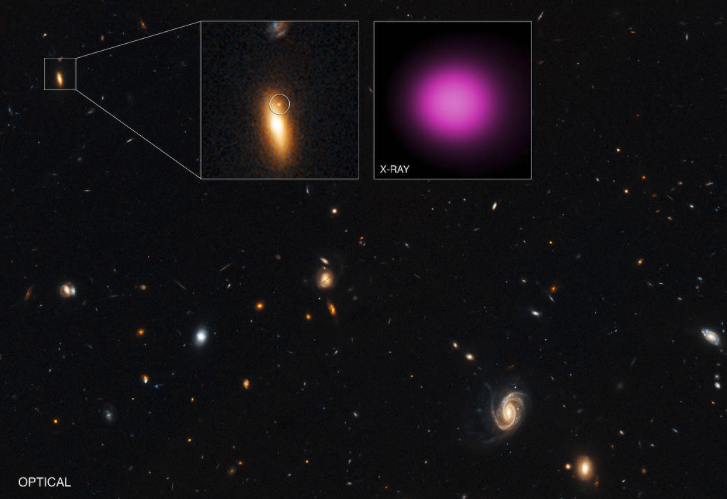
The main panel of this graphic has a wide-field, optical light image from the Hubble Space Telescope. The black hole and its host galaxy are located within the box in the upper left. The inset on the left contains Hubble’s close-up view of GJ1417+52. Within this inset the circle shows a point-like source on the northern outskirts of the galaxy that may be associated with XJ1417+52.
The inset on the right is Chandra’s X-ray image of XJ1417+52 in purple, covering the same region as the Hubble close-up. This is a point source, with no evidence seen for extended X-ray emission.
Image credit: X-ray: NASA/CXC/UNH/D.Lin et al; Optical: NASA/STScI
Astronomers discovered a peculiar object that could be a wandering black hole. The observations were made using NASA’s Chandra X-ray Observatory and ESA’s XMM-Newton X-ray Observatory.
Most, if not all, galaxies have a supermassive black hole in their centres. Nevertheless, these objects can also be found away from the centre of the galaxy. This may occur when two galaxies, that both contain a supermassive black hole, collide. Based on the geometry of the collision, gravitational forces may expel one of the two black holes in the outer parts of the merging system.
Now scientists suggest that this could be the explanation of the X-ray outburst that was observed in 2000 and 2002, and took place on the northern outskirts of the lenticular galaxy SDSS J141711.07+522540.8 (or GJ1417+52) that resides about 4.5 billion light years from Earth. At its peak the source, named XJ1417+5, was about ten times more luminous that the brightest X-ray source ever seen for a wandering black hole, classifying it as a “hyper-luminous X-ray source” (XLF). Later observations in X-rays, in 2005, 2014 and 2015 failed to detect the source, as its X-ray brightness was declined by at least of factor of 14. Astronomers suggest that the high X-ray emission, observed in 2000 and 2002, originated from material that was falling into the black hole, i.e. a star that was torn apart by tidal forces, as it was passing close to the black hole.
Publication: Lin et al. 2016
Source: NASA
